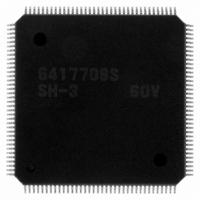HD6417708SF60V Renesas Electronics America, HD6417708SF60V Datasheet - Page 71

HD6417708SF60V
Manufacturer Part Number
HD6417708SF60V
Description
IC SUPERH MPU ROMLESS 208LQFP
Manufacturer
Renesas Electronics America
Series
SuperH® SH7700r
Datasheet
1.HD6417708SF60V.pdf
(635 pages)
Specifications of HD6417708SF60V
Core Processor
SH-2
Core Size
32-Bit
Speed
60MHz
Connectivity
EBI/EMI, SCI, SmartCard
Peripherals
POR, WDT
Number Of I /o
8
Program Memory Type
ROMless
Voltage - Supply (vcc/vdd)
3 V ~ 3.6 V
Oscillator Type
External
Operating Temperature
-20°C ~ 75°C
Package / Case
208-LQFP
Lead Free Status / RoHS Status
Lead free / RoHS Compliant
Eeprom Size
-
Ram Size
-
Program Memory Size
-
Data Converters
-
Available stocks
Company
Part Number
Manufacturer
Quantity
Price
Company:
Part Number:
HD6417708SF60V
Manufacturer:
Renesas Electronics America
Quantity:
10 000
Part Number:
HD6417708SF60V
Manufacturer:
RENESAS/瑞萨
Quantity:
20 000
- Current page: 71 of 635
- Download datasheet (3Mb)
3.1
3.1.1
The SH7708 Series has an on-chip memory management unit (MMU) that implements address
translation. The SH7708 Series features a resident translation lookaside buffer (TLB) that caches
information for user-created address translation tables located in external memory. It enables high-
speed translation of virtual addresses into physical addresses. Address translation uses the paging
system and supports two page sizes (1 kbyte and 4 kbytes). The access right to virtual address
space can be set for privileged and user modes to provide memory protection.
3.1.2
The MMU is a feature designed to make efficient use of physical memory. As shown in figure 3.1,
if a process is smaller in size than the physical memory, the entire process can be mapped onto
physical memory. However, if the process increases in size to the extent that it no longer fits into
physical memory, it becomes necessary to partition the process and to map those parts requiring
execution onto memory as occasion demands ((1)). Having the process itself consider this
mapping onto physical memory would impose a large burden on the process. To lighten this
burden, the idea of virtual memory was born as a means of performing en bloc mapping onto
physical memory ((2)). In a virtual memory system, substantially more virtual memory than
physical memory is provided, and the process is mapped onto this virtual memory. Thus a process
only has to consider operation in virtual memory. Mapping from virtual memory to physical
memory is handled by the MMU. The MMU is normally controlled by the operating system,
switching physical memory to allow the virtual memory required by a process to be mapped onto
physical memory in a smooth fashion. Switching of physical memory is carried out via secondary
storage, etc.
The virtual memory system that came into being in this way is particularly effective in a time-
sharing system (TSS) in which a number of processes are running simultaneously ((3)). If
processes running in a TSS had to take mapping onto virtual memory into consideration while
running, it would not be possible to increase efficiency. Virtual memory is thus used to reduce this
load on the individual processes and so improve efficiency ((4)). In the virtual memory system,
virtual memory is allocated to each process. The task of the MMU is to perform efficient mapping
of these virtual memory areas onto physical memory. It also has a memory protection feature that
prevents one process from inadvertently accessing another process’s physical memory.
When address translation from virtual memory to physical memory is performed using the MMU,
it may happen that the relevant translation information is not recorded in the MMU, with the result
that one process may inadvertently access the virtual memory allocated to another process. In this
Overview
Features
Role of MMU
Section 3 Memory Management Unit (MMU)
51
Related parts for HD6417708SF60V
Image
Part Number
Description
Manufacturer
Datasheet
Request
R

Part Number:
Description:
KIT STARTER FOR M16C/29
Manufacturer:
Renesas Electronics America
Datasheet:

Part Number:
Description:
KIT STARTER FOR R8C/2D
Manufacturer:
Renesas Electronics America
Datasheet:

Part Number:
Description:
R0K33062P STARTER KIT
Manufacturer:
Renesas Electronics America
Datasheet:

Part Number:
Description:
KIT STARTER FOR R8C/23 E8A
Manufacturer:
Renesas Electronics America
Datasheet:

Part Number:
Description:
KIT STARTER FOR R8C/25
Manufacturer:
Renesas Electronics America
Datasheet:

Part Number:
Description:
KIT STARTER H8S2456 SHARPE DSPLY
Manufacturer:
Renesas Electronics America
Datasheet:

Part Number:
Description:
KIT STARTER FOR R8C38C
Manufacturer:
Renesas Electronics America
Datasheet:

Part Number:
Description:
KIT STARTER FOR R8C35C
Manufacturer:
Renesas Electronics America
Datasheet:

Part Number:
Description:
KIT STARTER FOR R8CL3AC+LCD APPS
Manufacturer:
Renesas Electronics America
Datasheet:

Part Number:
Description:
KIT STARTER FOR RX610
Manufacturer:
Renesas Electronics America
Datasheet:

Part Number:
Description:
KIT STARTER FOR R32C/118
Manufacturer:
Renesas Electronics America
Datasheet:

Part Number:
Description:
KIT DEV RSK-R8C/26-29
Manufacturer:
Renesas Electronics America
Datasheet:

Part Number:
Description:
KIT STARTER FOR SH7124
Manufacturer:
Renesas Electronics America
Datasheet:

Part Number:
Description:
KIT STARTER FOR H8SX/1622
Manufacturer:
Renesas Electronics America
Datasheet:

Part Number:
Description:
KIT DEV FOR SH7203
Manufacturer:
Renesas Electronics America
Datasheet:











